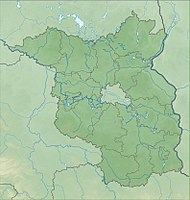Kindelsee Springluch
|
Kindelsee Springluch
|
||
|
Erlenbruchwald at Kindelfließ |
||
| location | Brandenburg , Germany | |
| surface | 69 hectares | |
| WDPA ID | 318652 | |
| Geographical location | 52 ° 38 ′ N , 13 ° 20 ′ E | |
|
|
||
| Setup date | July 31, 2001 | |
Kindelsee-Springluch is a 69 hectare nature reserve (NSG), which is located within the Brandenburg landscape protection area (LSG) West Barnim.
It is part of the Barnim Nature Park and belongs to the communities Glienicke / Nordbahn and Schönfließ . In 2001 it was declared a nature reserve by the Ministry of Agriculture, Environmental Protection and Regional Planning (MLUR). Since then, the subject matter and purpose of protection, prohibitions, permissible actions, maintenance and development measures, etc. can be read in the ordinance of July 22, 2001.
Nature reserve
As part of the East Brandenburg plate, the nature reserve is criss-crossed by gullies from the Ice Age, which were filled with sediments by wind and water erosion and which today bear alder forests , meadows and silting bogs. As a protected area close to the city, the forest-dominated area has an important recreational function.
In the center of the nature reserve traversed by the Kindel river is the Kindelsee, which, with its original circumference and a depth of 12 to 15 meters, represented the largest extension of the Kindel river. In the 1960s, as a result of soil improvement measures, the Kindel river was diverted around the lake, after which the water fell dry for a few years. In the 1990s, the inflow of the Springluchgraben into the Kindelfließ was closed and instead fed into the Kindelsee, whereupon the lake was filled with water again. Today the lake is heavily silted up by mud deposits and rich in nutrients. The lake area has valuable vegetation zoning as a late stage of water silting up. The water surface is enclosed by a reed belt about 30 meters wide , which is adjoined by willow bushes, wet meadows and alder swamps. Mixed oak forests with birch and pine stand on drier locations around the lake . The nature reserve offers a valuable habitat for a multitude of animal and plant species , not least because of its biodiversity .
Habitats and communities worth protecting
- Wet meadows
- Mixed oak forests of sour soil locations
- Alder forests
- Kindelfließ with Flachsee and fen area (silting up more and more)
Animal and plant species
The Kindelsee and the surrounding reed belt offer a suitable habitat for fish, amphibians, birds, insects and otters. Numerous bat and bird species find quarters, retreats and food in the structurally rich forests. Since 2010 there has been an ornithological inspection every year in April . So far, more than 30 bird species have been mapped:
- Blackbird ( Turdus merula )
- White wagtail ( Motacilla alba )
- Blue tit ( Parus caeruleus )
- Chaffinch ( Fringilla coelebs )
- Great Spotted Woodpecker ( Dendrocopos major )
- Distelfink / Stieglitz ( Carduelis carduelis )
- Siskin ( Carduelis spinus )
- Eurasian Jay ( Garrulus glandarius )
- Fitis ( Phylloscopus trochilus )
- Garden warbler ( Sylvia borin )
- Goldenhammer ( Emberiza citrinella )
- Gray heron ( ardea cinerea )
- Green Woodpecker ( Picus viridis )
- Hawfinch ( Coccothraustes coccothraustes )
- Great tit ( Parus major )
- Common raven ( Corvus corax )
- Crane ( grus grus )
- Middle Woodpecker ( Dendrocopos medius )
- Blackcap ( Sylvia atricapilla )
- Nightingale ( Luscinia megarhynchos )
- Golden Oriole ( Oriolus oriolus )
- Barn swallow ( Hirundo rustica )
- European robin ( Erithacus rubecula )
- Red kite ( Milvus milvus )
- Rohrschwirl ( Locustella luscinioides )
- Song thrush ( Turdus philomelos )
- Mallard Duck ( Anas platyrhynchos )
- Pied flycatcher ( Ficedula hypoleuca )
- White stork ( Ciconia ciconia )
- Treecreeper ( Certhia familiaris )
- Wren ( Troglodytes troglodytes )
- Chiffchaff / willow warbler ( Phylloscopus collybita )
In June 2010, vegetation surveys were taken for parts of the protected area. In addition, a biotope type mapping of the entire area is available. Occurring plant species include swamp pippau , swamp horsetail , swamp sedge , river dock , swamp blood-eye , lily of the valley and mountain elm .
Protection purpose
- Preservation and development of the Kindelsee and Feucht-Niedermoor environment
- Biotope network between Tegeler Fließ and Katharinensee
- Preservation of structural wealth
The silting zones around the Kindelsee are to be left to develop undisturbed towards natural swamp forests. Targeted nature conservation and maintenance measures are carried out in the area in order to preserve biotopes or to return them to potentially natural vegetation . The problem in the area is the growth of the late blooming bird cherry ( Prunus serotina ), an immigrant from North America, which spreads quickly and suppresses native tree species in their natural regeneration.
NABU Foundation for National Natural Heritage
In 2005, the NABU Foundation for National Natural Heritage acquired 26.6 hectares from the trust successor company BVVG . These were mixed forests with birch, pine and oak, fallow grassland of the damp lowlands and silting areas of the Kindelsee. Another 10 hectares were added in 2010. Since 2009, volunteer conservation area managers have been committed to maintaining, maintaining and developing the area. The priority tasks are data collection, information and public relations work, participation in the planning of measures and monitoring of the development of the area. The measures do not amount to changing the existing population, as process protection is practiced in most of the NABU area (with the exception of meadows) .
Web links
- NABU Foundation for National Natural Heritage: www.naturerbe.de
- Profile (PDF; 291 kB)
- Barnim Nature Park


